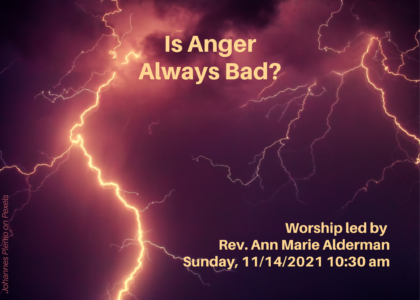Please click here to watch Rev. Ann Marie’s video recording of this sermon.
I learned, when I was in therapy some years ago, that the anger I often felt was indicative of a much deeper sorrow; a sorrow that I had learned to cover up, to hide from, with anger. For some reason, I thought it was okay to be angry, but not okay to be sad. My therapist helped me understand that I was afraid I would drown in the sadness if I really let myself know the depth of it. I wouldn’t say the counselor helped me learn to “let go” of the sadness I felt. What she did was give me permission to know it, to let me feel the sadness.
It was later that I learned how to use my anger. I’m still learning.
Perhaps we could all use a refresher not on how to be sad (I think we’ve got that now), but on how to be angry. How to be angry without causing harm. Angry enough to help destroy what needs to be destroyed, to change what needs to be changed, in a way that causes not more harm, but allows more justice to be born.
On the micro-leveI (on the personal side), I think we could all use help learning how to express anger, rather than suppress it. Especially in congregational settings, we try to be “nice.” In so doing, we sometimes don’t allow anger to be as useful as it could be. Learning that would be a step toward emotional intelligence, and we could all use more of that.
When Holly Near, the great singer and songwriter, wrote the song about being a gentle, angry people, what did she mean?
How can we be both at the same time, both angry and a gentle people? Angry and non-violent, not causing harm, but repairing wrongs and making right? Aristotle famously said we have to be angry “with the right person and to the right degree and at the right time and for the right purpose, and in the right way.”
Doing that isn’t easy!
We are learning how important it is to be angry when that is the emotion we feel. Some of us need permission to be angry. Some of us don’t need that. Instead, we may need to learn that our anger is too much for the situation at hand. That our anger draws a focus on us, when really it should be elsewhere. I am guessing that most of us are quite aware that there is plenty to be angry about.
But how, and when?
For a very long time, anger has had a bad reputation as a “negative” emotion. Yet, more and more social and evolutionary psychologists, brain scientists, and mental health professionals are suggesting that anger has valuable qualities and can be quite beneficial. Anger can be a vehicle that helps us be more informed and better able to adapt our response so that we engage better with the world around us. It is clear that people who know how to make the best use of anger are not usually “the victims,” but are more able of controlling their situations. The term developmental psychologists used to use for this skill was “mastery,” the skill needed to effect necessary change. I think it might be best to leave that word and its implications behind. We need power equity, not mastery.
Evolutionary psychologists are teaching that all human emotions came into being to keep us safe. It is clear that the elemental “fight response” stems from anger. Anger once served the purpose of helping us survive by causing us to be vigilant about threats and to act quickly and forcefully to protect ourselves or those dependent upon us and in our care.
We’ve all heard stories about the sudden superhuman strength that comes when an ordinary person rescues someone from what appears to be certain death. That strength comes from anger, the emotion, or—one could say—the moral indignation that says I’m not going to let this be the end of this story!
When one gets angry, one feels not just emotional pain, but often also physical pain. The physical pain is that tension that can be felt not just in the heart, but in the body. By doing something to physically express anger, one then can release the tension. The result is to then feel calmer.
We’ve all been taught that one must be in a calm state to think clearly. Perhaps that is true. But there are situations when we don’t have time to think.
I knew a person some years ago whose fight response was always on a quick trigger. She, like many women, learned early on that she wasn’t going to win a physical fight with at least with the 50% of the population she chose as intimate partners. So, she learned to always have a stack of chipped ceramic dishes around, and whenever she felt overwhelmed with anger—so overwhelmed she wasn’t able to calm down or think clearly—she would throw one or more of those plates at a hard surface. She got her cool back that way, and her ability to “win” an argument or solve a conflict would return.
Anger’s discharge can be calming. We all should have some means to discharge anger that doesn’t harm ourselves or anyone else. Throwing ceramics at concrete might be yours. Physical exercise can work, too. My foster teen has learned to go for a walk when he is angry. I vacuum, or vigorously trim bushes, or the like.
All of psychology seems certain that anger is intimately related to the deep need human beings have for control.
That notion is what Black leaders mean when they try to help white folk see that the kind of Black rage that destroys buildings and property is fueled by the human need to be in control. It is better than remaining helpless victims in the face of another act of injustice.
Rage may not build bridges, but it is an avenue for change. What is needed on a personal and a societal level is a way to allow anger—especially the anger that comes when rights are being denied, when disrespectful behavior is allowed, when acts of exploitation rule—to say, “This isn’t right.”
Anger that is communication about a sense of unfairness needs to be given a channel that makes for change; destroying what needs to be destroyed in order to make way for creating what needs to come into being.
Allowing anger to be expressed can trigger optimism. Anger should be allowed, even encouraged, when its focus is on what is hoped will be achieved, rather than on the injustice. It may start by saying we aren’t going to put up with this anymore.
Psychologists tell us that the full discharge of anger is focused on what is attainable, and not the opposite. When we let ourselves feel angry and discharge the anger, we feel positive about our ability to change the situation, and that empowers us to take action and move in the necessary direction. We will calm down and think our way through to a rational solution, perhaps, but first we must allow the effectiveness of anger expressed with appropriate intensity to the situation to do its thing.
Anger emboldens quick and decisive action. It is activated when our values are not in harmony with the situation, making us aware of what we really stand for. That’s emotional intelligence at work.
A long time ago, I was driving back to my family’s wood flooring business near the end of the day. It was probably a Saturday. Our building was in a part of town where a lot of service businesses were located. My family installed and refinished wood floors, so we had a warehouse full of flooring and supplies, a warehouse yard full of service trucks, another building with offices and a showroom. Our property was just like many other service operations with small warehouses, service vehicles, offices, and showrooms in the same area. This area had long also housed a tight-knit neighborhood full of small homes and churches. I was driving through the heart of the neighborhood and noticed a man walking down the sidewalk in front of three small children. All of a sudden one of those children darted out into the road. I was able to stop. But a car coming from the other direction didn’t see what was happening until too late and the child was knocked down by his car. All of a sudden, other adults (parents, I assume) came from everywhere, shouting at the man who was with these young children. These neighbors were shaming him. I didn’t speak, but I did call the EMTs. The child was okay; she stood up and ran back to the sidewalk. After the EMTs examined her, she walked home.
I’ll never forget the anger and the shaming that man received. It was powerful. How dare you let this happen! You are a fool, they shouted. It wasn’t my place to shout or shame. But it was theirs.
Whenever someone seems to put a lower value on you or someone in your care than they put on themselves, anger can erupt. Psychologists say anger is designed to recalibrate the situation, and in so doing, bring equity to the parties involved. Anger is our immediate way of strongly asserting our sense of justice so strongly it may lead to immediate compliance.
On a macro-level, we can see that anger at racial injustices can be a powerful motivating force for social justice work. That kind anger needs to be acknowledged and cultivated. This is what Myisha Cherry says in her new book, The Case for Rage: Why Anger is Essential to Anti-Racist Struggle. She distinguishes what she calls inclusive anger from all other forms of anger. Inclusive anger is the moral indignation that comes from believing that one is not free while others are not free. Long before Cherry, Audre Lorde talked about this kind of anger, saying that it was an absolutely appropriate reaction to racist attitudes and actions.
It is anger that is about destroying the racist beliefs, expectations, policies, and behaviors that shape and support white supremacy in order to make way for the freedom of all humans.
The rage that Cherry talks about can be called morally appropriate when it respects the humanity of the wrongdoer and aims to create a better world.
I talked about Soul Force last Sunday. This kind of inclusive anger is part of soul force.
“Something is not right here and it’s hurting my people.”
Anger is not always bad.
Because I see I am talking to a mostly white audience, let me add the caveat that white folks pretending they know the depth and hurt of Black rage and can therefore use their white folk anger to make things happen are causing harm. White allies have a place, but “when the focus becomes all about the rage good white people have against racism, rather than the racism to be fought against, then injustice gets ignored.” Anger is not a bad thing. Yet, our anger should be directed at the systemic injustice and not those who have been harmed by it—which is all of us.
If you appreciated this reflection, please text to give or visit our Give Now page to support the UUCSH Share the Plate efforts to assist those in need.

